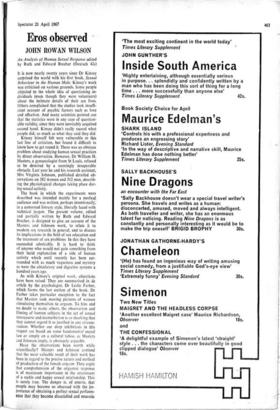Eros observed
JOHN ROWAN WILSON
An Analysis of Human Sexual Response edited by Ruth and Edward Brecher (Deutsch 42s) It is now nearly twenty years since Dr Kinsey surprised the world with his first book, Sexual Behaviour in the Human Male. Kinsey's work was criticised on various grounds. Some people objected to the whole idea of questioning in- dividuals (even though they were volunteers) about the intimate details of their sex lives. Others complained that the studies took insuffi- cient account of psychic factors such as love and affection. And many scientists pointed out that the statistics were in any case of question- able validity, since they were inevitably acquired second hand. Kinsey didn't really record what people did, so much as what they said they did.
Kinsey himself felt very vulnerable to this last line of criticism, but found it difficult to know how to get round it. There was an obvious problem about studying human sexual practices by direct observation. However, Dr William H. Masters, a gynaecologist from St Louis, refused to be deterred by a seemingly insuperable obstacle. Last year he and his research assistant, Mrs Virginia Johnson, published detailed ob- servations on 382 Women and 312 men, describ- ing the physiological changes taking place dur- ing sexual activity.
The book in which the experiments were described was intended mainly for a medical audience and was written, perhaps intentionally, in a contorted literary style, liberally laced with technical jargon. The present volume, edited and partially written by Ruth and Edward Brecher, is designed to give an account of the Masters and Johnson work, to relate it to modern sex research in general, and to discuss its implications in the field of sex education and the treatment of sex problems In this they have succeeded admirably. It is hard to think of anyone who would not gain something from their lucid explanation of a side of human activity which until recently has been sur- rounded with as much' vagueness and mystery as were the circulatory and digestive systems a hundred years ago.
As with Kinsey's original work, objections have been raised. They are summarised in in article by the psychologist, Dr Leslie Farber, which forms the last section of the book. Dr Farber takes particular exception to the fact that Masters took moving pictures of women stimulating themselves 'to orgasm. To him and no doubt to many others, the observation and filming of human subjects in the act of sexual intercourse and masturbation is so shocking that they cannot regard it as justified in any circum- stances. Whether our deep inhibitions in this respect are based on some fundamental moral law or simply on a cultural taboo, as Masters and Johnson imply, is obviously arguable.
Have the observations been worth while scientifically? Masters and Johnson contend that the most valuable result of their work has been in regard to the precise nature and method of production of the female orgasm. They argtfe that comprehension of the orgasmic response is of maximum importance in the attainment of a stable and happy sexual relationship. This is surely true. The danger is, of course, that people may become so obsessed with the im- portance of obtaining a perfect sexual perform- ance that they become dissatisfied and neurotic if they fall short of it. Such enhanced self-con- sciousness is a well-known hazard in teaching any physical technique or rule of health. It is a call for skill and sensitivity rather than an argu- ment against education itself. The doctor's task, in relation to sex or any other form of health problem, is to explain to men and women how to behave sensibly in relation to their own bodies, yet at the same time to avoid turning them into hypochondriacs. Whatever we may think about the experimental method used by Masters and Johnson their observations have made a signi- ficant contribution towards this end.







































 Previous page
Previous page